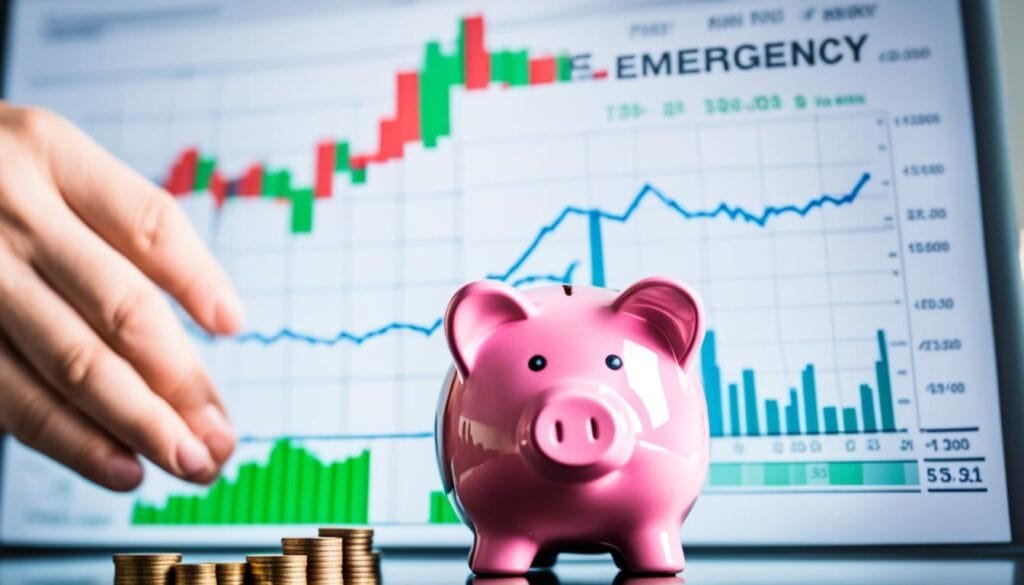Did you know that as of 2023, nearly 44 percent of U.S. adults cannot cover a $1,000 emergency expense from their savings1? This alarming statistic highlights the critical nature of understanding the difference between emergency savings and investments in today’s financial landscape. Balancing these two essential components of personal finance can significantly impact your financial security and growth potential. While many may understand the necessity of an emergency fund, the allure of higher returns from investments often leads individuals to overlook this crucial safety net.
In this article, we will delve into the distinct roles that emergency savings and investments play in financial planning, helping you to determine which should take precedence based on your circumstances and future goals. With the average credit card annual percentage rate (APR) surpassing 22%2, the pressure to have a robust emergency fund has never been more evident. As you read on, you’ll learn that a sound financial strategy should encompass both a safety net for unforeseen circumstances and avenues for growth through various investment options.
Key Takeaways
- 44% of U.S. adults cannot cover a $1,000 emergency expense from savings.
- Emergency savings and investments serve distinct roles in financial planning.
- Balancing savings and investments is crucial for maximizing financial security.
- The average credit card APR is currently over 22%, stressing the importance of an emergency fund.
- Understanding financial goals is key to deciding between saving and investing.
Understanding the Necessity of Emergency Savings
In today’s unpredictable financial landscape, the importance of emergency savings cannot be overstated. These funds act as a safety net, providing security during unexpected expenses like medical emergencies, home repairs, or job loss. A solid emergency fund becomes vital for personal finance management, allowing individuals to navigate life’s uncertainties without falling into debt.
What Constitutes Emergency Savings?
Emergency savings consist of liquid assets set aside specifically for urgent situations. Financial experts typically recommend having three to six months’ worth of essential monthly expenses saved for emergencies, which can include costs like rent, utilities, groceries, health care, and minimum debt payments3. Additionally, starting with a more immediate savings goal, such as $1,000, can help individuals develop a habit of saving4.
Statistics on Emergency Savings in the U.S.
Recent surveys reveal alarming trends regarding emergency savings among Americans. More than 35% of Americans would struggle to cover an unexpected $400 expense, indicating a lack of financial preparedness4. Furthermore, approximately 25% of adults admit to having no emergency savings at all, which could lead them to rely on credit cards or loans, ultimately pushing them into further debt5.
Benefits of Maintaining an Emergency Fund
The benefits of emergency funds extend beyond immediate financial relief. Having these savings helps prevent dependence on high-interest credit options, offering peace of mind during uncertain times5. In addition, an emergency fund allows for flexible financial planning, enabling individuals to handle various unexpected costs without compromising their overall financial stability. Utilizing automated savings techniques can also make it easier to maintain and grow these funds over time3.

Assessing the Role of Investments
Investments are a critical component of financial planning. They can help individuals grow their wealth and meet long-term financial goals. Understanding the various investment vehicles available is essential for making informed investment decisions and aligning them with one’s risk tolerance.
Different Types of Investment Vehicles
Investment vehicles come in various forms, each offering distinct risk and reward profiles. Some common options include:
- Stocks: Ownership in a company, which can provide high returns but comes with considerable volatility.
- Bonds: Debt securities that typically offer fixed returns over time with lower risk compared to stocks.
- Mutual Funds: Pooled funds managed by professionals, providing diversification across multiple assets.
- ETFs: Exchange-traded funds that function similarly to mutual funds but trade like stocks.
- Commodities: Physical assets like gold or oil, which may serve as a hedge against inflation.
Each of these investment vehicles presents varying levels of risk and potential rewards, making it essential for investors to assess their risk tolerance before diving in.
The Long-term Benefits of Investing
Investing offers several long-term benefits that can significantly enhance financial growth. Over time, investments have the potential to outpace inflation, with higher returns compared to traditional saving options. Individuals looking toward retirement or other long-term objectives must consider the compounding effect of investments, where returns generate additional earnings, leading to exponential growth. Prioritizing investments suitable for one’s financial goals can shift the path to financial security.
Understanding Risk Tolerance in Investments
Risk tolerance plays a pivotal role in determining an individual’s investment strategy. This concept encompasses several factors, including age, income, and personal financial goals. Those with lower risk tolerance may prefer safer options like bonds and savings accounts, while those open to more volatility can explore aggressive investment vehicles like stocks or commodities. It is crucial for investors to evaluate their financial situation comprehensively and maintain a diversified portfolio to mitigate risks and maximize potential growth opportunities. Financial advisors often recommend that an individual maintain an emergency fund covering three to six months of expenses before engaging in higher-risk investments, ensuring security in times of need6
Emergency Savings or Investment: Which Should Come First?
Understanding the balance between emergency savings and investments is vital for achieving financial security. Establishing clear financial goals lays the groundwork for effective decision-making. Individuals focusing on short-term objectives, such as unexpected medical expenses, should prioritize liquidity over growth. This means having accessible funds in an appropriate savings account. According to financial experts, the average recommended emergency fund should cover three to six months of living expenses7. Therefore, a good starting point for an emergency fund could be at least $500 but aiming to build it up to cover half a year’s worth of expenses is advisable7.
The Importance of Financial Goals
Setting specific financial goals helps individuals determine their priorities. Those who are preparing for imminent expenditures must opt for saving vs investing strategies that favor liquidity. Having an emergency fund can help individuals avoid using credit cards or loans for unexpected expenses, preventing the growth of debt due to interest and fees8.
How Time Horizon Affects Your Decision
Time horizon significantly influences financial decisions. Funds that are needed within the next 12 months should remain in more accessible savings options to ensure that they can be quickly retrieved when necessary. Alternatively, funds set aside for multi-year goals can be invested for growth, capitalizing on the potential higher returns that investments often offer. Regular contributions to savings, even small amounts, can lead to steady growth over time8. By utilizing savings planning tools, individuals can better understand the time required to reach their savings goals based on how often they contribute.
Prioritizing Liquidity vs. Growth
The decision between liquidity vs growth is crucial in shaping a sound financial strategy. By keeping emergency funds in a bank or credit union account, individuals ensure that their savings are safe and easily accessible8. High-yield savings accounts offer competitive interest rates, such as 4.60% APY with conditions on Direct Deposits, providing a substantial incentive for saving7. Alternatively, other savings options, such as money market accounts with rates around 4.00% APY and Certificates of Deposit (CDs) that can yield rates between 5.10% and 5.30% APY, can be considered depending on how liquid the funds need to remain7. This necessitates regular monitoring of savings progress and setting clear guidelines on when to use emergency funds to distinguish true emergencies from non-essential expenses.
Pros and Cons of Saving vs. Investing
When navigating the finance landscape, understanding the pros and cons of saving and investing becomes essential for financial well-being. Emergency savings serve as a crucial safety net, providing immediate access to funds with virtually no risk. This characteristic allows individuals to handle unexpected expenses efficiently. For example, maintaining a savings account is recommended to cover three to six months’ worth of living expenses as a buffer against financial emergencies9.
Advantages of Emergency Savings
Emergency savings come with several distinct advantages. They provide high liquidity, ensuring that funds are readily available when needed, a crucial factor during emergencies10. Savings accounts offer a stable return that, while lower than investment returns, carries no risk of loss. For instance, FDIC-insured accounts guarantee protection against bank failure, securing deposits up to $250,00010. Such safety makes savings ideal for short-term goals or urgent financial needs. Moreover, high-yield savings accounts, like those offered by Marcus by Goldman Sachs, can provide return rates such as 4.40% APY, although these often lag behind the potential returns from investing9.
Disadvantages of Relying Solely on Investments
Despite their potential for higher returns, investments come with disadvantages. Market volatility can lead to significant losses, posing a risk that may not be suitable for everyone10. Individuals relying solely on investments risk missing out on essential liquidity. They should have sufficient emergency funds in place before committing large sums to long-term investment strategies. Furthermore, those without a solid emergency fund may find themselves in financial distress during unexpected circumstances, potentially leading to unwise borrowing decisions11.
Finding a Balance: Saving and Investing Together
Achieving financial stability involves finding a balance between saving and investing. A diversified approach enables individuals to meet immediate financial needs while nurturing long-term growth. It is advisable for investors to ensure they have an emergency fund covering several months of expenses before allocating funds into investment accounts (which could yield average annual growth of about 7% after inflation)11. Assessing one’s risk tolerance is essential in this balance; individuals comfortable with risk may opt for investments, while those prioritizing security might lean more toward savings. Ultimately, a comprehensive personal finance strategy incorporates both elements to foster well-rounded financial health.
Conclusion
When considering your financial decision-making, it’s evident that a strong foundation in emergency savings is essential before venturing into investments. Prioritizing an emergency fund helps safeguard against unexpected expenses, with a recommendation to have three to six months’ worth of living expenses set aside within two to three years12. This practice not only provides peace of mind but also enhances your capacity to invest wisely when the time is right.
In aligning your financial goals with your current situation, understanding the risks associated with both savings and investments is crucial. Immediate savings typically offer lower yields; however, they ensure liquidity and security13. On the other hand, diversifying your investments over the long term can lead to substantial growth, influenced by compounding returns and careful asset allocation13.
Ultimately, mastering the balance between emergency savings and investment strategies is vital for achieving financial stability and long-term success. Reflect on your individual circumstances, risks, and goals to align your saving and investing strategies effectively, ensuring that you embark on your journey toward financial independence with a solid foundation.
FAQ
What constitutes emergency savings?
How much should I have in my emergency savings fund?
What are the primary benefits of maintaining an emergency fund?
What types of investment vehicles should I consider?
How can I determine my risk tolerance for investing?
What role does time horizon play in saving vs. investing?
What are the pros and cons of saving vs. investing?
How can I find a balance between saving for emergencies and investing for the future?
Source Links
- https://www.bankrate.com/banking/savings/when-to-use-emergency-fund/
- https://www.experian.com/blogs/ask-experian/should-you-invest-emergency-fund/
- https://smartasset.com/financial-advisor/emergency-funds-vs-savings-accounts
- https://www.fidelity.com/learning-center/smart-money/emergency-fund
- https://www.affinityfcu.com/financial-wellbeing/blog/personal-banking/emergency-savings-or-your-retirement-goals
- https://www.investopedia.com/should-you-save-your-money-or-invest-it-depends-4692975
- https://www.nerdwallet.com/article/banking/emergency-fund-why-it-matters
- https://www.consumerfinance.gov/an-essential-guide-to-building-an-emergency-fund/
- https://www.cnbc.com/select/saving-vs-investing/
- https://www.bankrate.com/investing/saving-vs-investing/
- https://www.fool.com/investing/how-to-invest/saving-vs-investing/
- https://www.nerdwallet.com/article/banking/saving-vs-investing-when-to-choose-how-to-do-it
- https://www.investopedia.com/articles/investing/022516/saving-vs-investing-understanding-key-differences.asp

